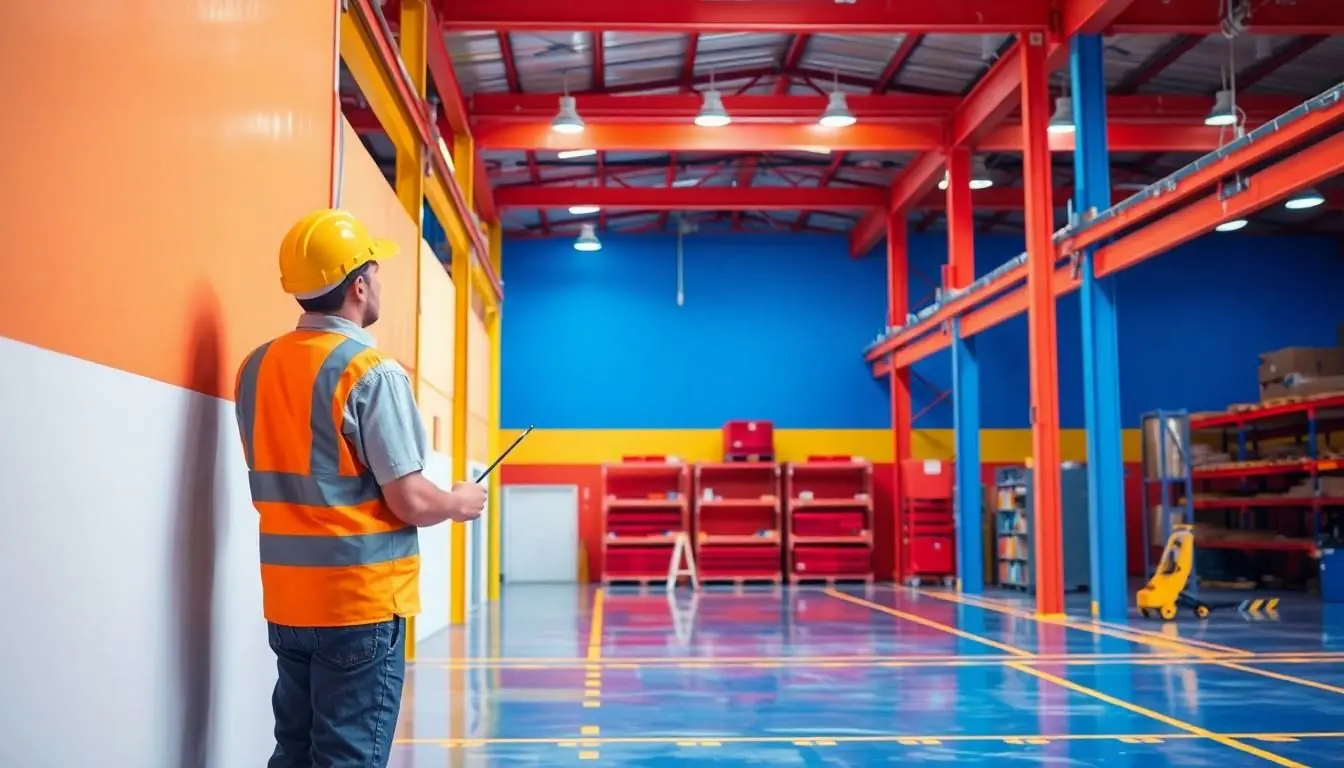In the world of warehouses, where boxes stack higher than a toddler’s Lego tower, a fresh coat of paint might not be the first thing that comes to mind. But hold on! Warehouse painting isn’t just about aesthetics; it’s like giving your space a much-needed spa day. A vibrant new look can boost morale, improve safety, and even help with inventory management. Who knew that a splash of color could be the secret ingredient to a thriving workspace?
Imagine walking into a warehouse that feels less like a dungeon and more like a well-organized masterpiece. Bright colors can enhance visibility and help employees navigate their tasks with ease. Plus, it shows clients that you care about your environment. So, if you think your warehouse could use a little TLC, it’s time to roll up those sleeves and get painting! After all, a happy warehouse is a productive warehouse.
Table of Contents
ToggleOverview of Warehouse Painting
Warehouse painting serves multiple purposes beyond just visual appeal. Enhancing employee morale ranks high among the benefits, as fresh colors can energize the work environment. Improved safety also results from thoughtful choices in paint colors, which can increase visibility for both personnel and machinery.
Specific color schemes contribute to an organized atmosphere, assisting in inventory management. Different shades help differentiate various sections of a warehouse, streamlining the retrieval process. The utilization of vibrant and engaging colors fosters a more productive workspace, where efficiency thrives.
Regular maintenance plays a critical role in prolonging the life of a warehouse. A well-maintained paint job protects surfaces from wear and tear, moisture, and other damages. Investing in quality paint ensures lasting results, reducing the frequency of repainting jobs.
Decision-making regarding paint types and colors must consider warehouse functionality. Selecting non-toxic and low-VOC (volatile organic compounds) paints is vital for maintaining air quality. Furthermore, choosing durable coatings aids in resisting scuffs and stains, which supports overall cleanliness and safety.
Certain industries may prefer specific colors to align with branding or operational needs. Consistency in color application reinforces a company’s image, while appropriately chosen hues can positively affect worker productivity and focus. Warehouse painting thus serves as a strategic investment in the success and well-being of the workforce.
Importance of Warehouse Painting

Warehouse painting significantly impacts various aspects of operations, combining aesthetic and practical benefits. A well-executed paint job enhances the environment and fosters a more efficient workflow.
Aesthetic Appeal
A fresh coat of paint instantly transforms a warehouse’s visual appeal. Bright, engaging colors capture attention and create an inviting atmosphere for employees and visitors. Color choices can reflect a brand’s identity, reinforcing its presence while promoting a positive workspace. Organized color schemes also aid in spatial orientation, helping staff quickly identify different areas. Enhanced aesthetics lead to improved morale among employees, encouraging a more productive work environment.
Safety and Compliance
Safety becomes a priority with thoughtful paint selections. High-visibility colors help delineate pathways and hazards, reducing the likelihood of accidents. Compliance with safety regulations also relies on using specific color codes for warning signs and equipment identification. Regularly maintained paint jobs ensure surfaces resist wear and tear, safeguarding against costly damage. Non-toxic, low-VOC options contribute to healthier air quality, protecting the well-being of all individuals in the facility. Prioritizing safety through appropriate warehouse painting not only meets regulations but also promotes a culture of care.
Types of Warehouse Paint
Selecting the right type of paint for a warehouse is essential for achieving optimal results. Different options offer various benefits tailored to specific needs.
Epoxy Coatings
Epoxy coatings stand out for their durability and resistance to wear and tear. These coatings create a hard, protective layer that withstands heavy foot traffic and machinery impact. Many warehouses opt for epoxy due to its excellent adhesion, ensuring the paint adheres securely to surfaces. It also provides protection against chemicals and oil spills, which are common in industrial environments. With a glossy finish, epoxy enhances visibility and brightens spaces, contributing to a safer work environment. Maintenance remains straightforward, requiring occasional cleaning rather than frequent repainting.
Acrylic Paints
Acrylic paints offer flexibility and quick drying times, making them ideal for warehouse applications. These paints are water-based, promoting lower levels of volatile organic compounds, which aids in maintaining air quality. Many warehouse managers prefer acrylic for its ease of application and vibrant color options, which improve visibility throughout the space. When used indoors, these paints create a pleasant atmosphere and enhance overall aesthetics. They also resist fading and chalking, ensuring long-lasting color retention. Additionally, acrylic paints can be mixed with additives for increased durability, making them suitable for various surfaces.
Preparation Process
Preparation plays a crucial role in achieving a successful warehouse painting project. Following the right steps ensures optimal results and longevity of the paint job.
Surface Cleaning
Surface cleaning eliminates dirt, dust, and grease, creating a suitable foundation for paint adhesion. Using a pressure washer can effectively remove built-up grime, while a broom or vacuum addresses loose debris. Certain surfaces might require specific cleaning agents to tackle stubborn stains. After cleaning, rinsing with clean water is essential to remove any residue. Allowing surfaces to dry thoroughly prevents moisture-related issues that can affect paint application.
Repairing Damages
Addressing damages in the warehouse is vital before applying new paint. Inspecting walls and floors helps identify cracks, holes, or peeling paint that need attention. Filling in holes or cracks with suitable filler compounds ensures a smooth surface for painting. Sanding any rough patches creates an even texture, enhancing the final appearance. Sorting out any structural issues, such as loose panels or damaged drywall, protects the integrity of the paint job, leading to enhanced durability.
Application Techniques
Warehouse painting involves various techniques, each suited for specific needs and conditions. Understanding these methods helps ensure an effective and durable finish.
Spraying
Spraying offers rapid coverage for large areas, making it ideal for expansive warehouse spaces. This technique utilizes air-powered sprayers, providing a fine mist of paint that allows for even distribution across surfaces. It effectively reduces application time, especially when working on ceilings or hard-to-reach areas. Choosing an airless sprayer avoids overspray, ensuring more paint stays on the surface. When using this method, proper ventilation is crucial, as it minimizes inhalation of fumes, fostering a safer environment. Selecting low-VOC paints further maintains air quality, aligning with warehouse safety protocols.
Rolling
Rolling provides a controlled application for smaller areas or detailed sections. This method allows workers to apply paint with precision, ensuring uniform coverage on walls and other surfaces. Rollers are particularly effective for applying thicker coats, which enhances durability and longevity of the paint. Using rollers with extended handles enables reach for tall surfaces without additional equipment. It’s essential to prepare rollers by saturating them correctly to prevent roller marks. A consistent technique aids in achieving a smooth finish while maintaining color integrity, which helps reflect brand identity and improves worker satisfaction.
Maintenance and Longevity
Regular maintenance of warehouse paint is essential for maximizing longevity. Frequent inspections identify areas requiring touch-ups or repairs. Clean surfaces regularly to prevent dirt and grime buildup, which can erode paint quality. High-traffic zones often require extra attention, as wear and tear can diminish a paint job’s effectiveness.
Utilizing appropriate cleaning agents helps maintain the paint’s integrity. Opt for non-abrasive cleaners to avoid damaging the finish. Immediate attention to peeling or cracked paint prolongs overall durability. Not addressing these issues leads to more extensive repairs and costs in the future.
Selecting high-quality paints also enhances longevity. Non-toxic, low-VOC options provide durability while ensuring air quality remains safe. Specific coatings, like epoxy, offer superior resistance to scuffs, stains, and chemicals, making them preferable for busy warehouses.
Routine repainting has its advantages. Scheduling repainting every three to five years ensures protection against wear and keeps the workspace looking fresh. Planning allows for choosing optimal seasons for application when airflow and curing conditions are favorable.
Color choices play a role in maintenance as well. Lighter shades may require more frequent touch-ups, while darker hues might conceal scuffs better but can fade faster under harsh lighting. Additionally, reflective finishes improve visibility and safety, which is vital for operational efficiency.
Proactive maintenance practices, quality paint selection, and strategic color choices collectively contribute to the longevity of a warehouse paint job. Prioritizing these factors fosters a safe, inviting environment that supports overall operations.
Investing in warehouse painting is a strategic move that offers numerous benefits beyond mere aesthetics. By choosing the right colors and high-quality paints, warehouse owners can create an inviting and efficient work environment. Enhanced visibility and organized spaces lead to improved safety and productivity.
Regular maintenance is essential to ensure the longevity of the paint, keeping the warehouse looking fresh and professional. Ultimately, a well-painted warehouse reflects a commitment to employee well-being and operational excellence. Embracing these practices not only fosters a positive atmosphere but also supports the overall success of the business.



